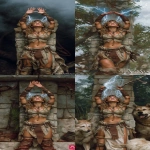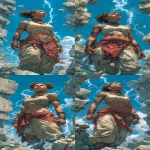Explore the Best AI Image Gallery

Beyond the Brush: How Wearable Tech is Transforming the Creative Landscape
The intersection of technology and creativity has always been a fertile ground for innovation. From the advent of digital art tools to the rise of 3D printing, each technological leap has reshaped how we create and experience art. Today, wearable technology stands at the forefront of this evolution, pushing the boundaries of artistic expression and blurring the lines between the physical and digital realms.
A Canvas on Your Skin: Wearable Tech as a Creative Tool
Wearable devices, such as smart glasses, haptic gloves, and motion-sensing suits, are empowering creators with unprecedented levels of control and interactivity.
- Interactive Installations: Imagine stepping into an art installation where your movements trigger soundscapes, light projections, or even the transformation of virtual objects. Wearable sensors can capture your every gesture and translate it into a dynamic, responsive environment, blurring the lines between spectator and participant.
- Gesture-Based Art: For painters, sculptors, and musicians, wearable tech can become an extension of their physical selves. Haptic gloves allow artists to feel virtual textures and shapes, while motion-sensing suits translate bodily movements into brushstrokes, sculpting motions, or musical compositions. This fusion of technology and physical expression opens up entirely new artistic possibilities.
- Augmented Reality Experiences: Smart glasses can overlay digital elements onto the real world, creating immersive art experiences that blend reality and imagination. Imagine exploring a cityscape where buildings come alive with digital murals or walking through a park where flowers bloom with virtual fireflies.
Bridging the Gap: Wearable Tech and Accessibility in Art
Wearable technology also has the potential to bridge the gap for individuals with disabilities, providing new tools for creative expression and participation.
- Assistive Devices: Individuals with limited mobility can use wearable devices to control virtual art tools or navigate immersive art experiences. Haptic feedback and voice-controlled interfaces can make art creation more accessible to people with visual or auditory impairments.
- Augmenting Abilities: Wearable technology can enhance existing creative abilities. For example, musicians with prosthetic limbs can use haptic gloves to feel the vibrations of instruments, while individuals with speech difficulties can utilize voice synthesis software controlled by wearable sensors to express themselves through music or poetry.
Ethical Considerations: Navigating the Uncharted Territory
As with any powerful technology, wearable tech raises ethical considerations that require careful attention.
- Privacy and Data Security: Wearable devices collect vast amounts of personal data, including location, movement patterns, and even biometric information. Ensuring the privacy and security of this data is paramount.
- Bias and Representation: The algorithms powering wearable technology can perpetuate existing biases if not carefully designed and monitored. Its essential to ensure that creative tools using wearable tech are inclusive and representative of diverse voices and perspectives.
- Ownership and Authenticity: The lines between human creativity and machine-assisted creation can become blurred with wearable tech. Questions arise regarding authorship, ownership, and the authenticity of art generated using these tools.
The Future of Creativity: A Wearable Horizon
Wearable technology is poised to revolutionize the creative landscape in profound ways. As devices become more sophisticated and seamlessly integrated into our lives, we can expect even more innovative applications that empower creators and redefine artistic expression.
- Immersive Storytelling: Wearable tech will enable immersive storytelling experiences that transport audiences directly into narratives, allowing them to interact with characters and environments in unprecedented ways.
- Collaborative Creation: Wearables will facilitate real-time collaboration between artists across geographical boundaries. Imagine musicians jamming together virtually, designers sharing their sketches in augmented reality, or writers co-creating stories using haptic feedback.
- Personalized Art Experiences: Wearable tech will allow for personalized art experiences tailored to individual preferences and emotions. AI-powered algorithms can analyze user data to curate artwork, music, and even interactive environments that resonate deeply with each person.
The future of creativity is a wearable horizon filled with endless possibilities. As we embrace this technological evolution, its crucial to approach it with thoughtful consideration for its ethical implications and strive to harness its power to create a more inclusive, expressive, and interconnected world.










](https://images.ai-img.art/thumbnails/150/bc5b40f43007c984885fc5b035e0fd81d75554a8730895e067565a6b7050524b.webp)






](https://images.ai-img.art/thumbnails/150/39c6bd41a1282b304a06fb11053bd009750b3879060719b1adb959228dbcd41a.webp)



















](https://images.ai-img.art/thumbnails/150/00df9b84a8818b4130bce9ca10c0c67ff2bc8952ca0fb5012dafc9b1c6378e67.webp)



](https://images.ai-img.art/thumbnails/150/8aa2589b60ffe3dde30a265a6cac8d4ae71901c658ca48c4344f21436de413fb.webp)




](https://images.ai-img.art/thumbnails/150/33a7122c923d87ba243a3afa0b16a930f1603be27b8ac938ff7f4ae4f5140553.webp)


